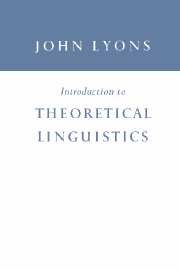Book contents
- Frontmatter
- Contents
- PREFACE TO THE 1995 EDITION
- 1 Linguistics: The Scientific Study of Language
- 2 The Structure of Language
- 3 The Sounds of Language
- 4 Grammar: General Principles
- 5 Grammatical Units
- 6 Grammatical Structure
- 7 Grammatical Categories
- 8 Grammatical Functions
- 9 Semantics: General Principles
- 10 Semantic Structure
- Notes and references
- Addenda
- Bibliography
- Table of symbols and notational conventions
- Index of proper names
- Index of subjects
- Frontmatter
- Contents
- PREFACE TO THE 1995 EDITION
- 1 Linguistics: The Scientific Study of Language
- 2 The Structure of Language
- 3 The Sounds of Language
- 4 Grammar: General Principles
- 5 Grammatical Units
- 6 Grammatical Structure
- 7 Grammatical Categories
- 8 Grammatical Functions
- 9 Semantics: General Principles
- 10 Semantic Structure
- Notes and references
- Addenda
- Bibliography
- Table of symbols and notational conventions
- Index of proper names
- Index of subjects
Summary
Immediate constituents
Concatenation and linearity
In our treatment of the general principles of ‘formal grammar’ in chapter 4, we deliberately adopted the view that all sentences had a simple linear structure: i.e. that every sentence of the language could be satisfactorily described, from the grammatical point of view, as a string (or sequence) of constituents (which we assumed to be words).
As an abstract illustration of what is meant by the term ‘string’ (which is the technical term used in mathematical treatments of the grammatical structure of language) we may consider the following instances:
a+b+c+d
The plus-sign is employed here (other conventions of notation are also to be found in the literature) to indicate concatenation (‘chaining together’). The string results from the combination of the constituents, or elements, in a particular order. What the order denotes depends upon the interpretation given to the system in its application to particular phenomena. In the case of natural languages, the left-toright ordering of the constituents in the string may be thought of as reflecting the time-sequence (from earlier to later) in spoken utterances or the left-to-right ordering of written sentences in the conventions used for English and most languages of the world today. At the same time, it should be realized that the same abstract principle of linear ordering might also be used for other purposes in the description of language.
- Type
- Chapter
- Information
- Introduction to Theoretical Linguistics , pp. 209 - 269Publisher: Cambridge University PressPrint publication year: 1968



